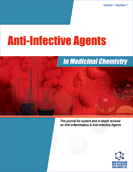Abstract
Peptidoglycan cell wall is an essential polymer for growth and development of most bacteria. The glycosyltransferase domain of bifunctional class A penicillin-binding proteins and monofunctional GTs proteins catalyze the polymerization of uncross linked glycan chains of the peptidoglycan whereas the penicillin-binding transpeptidases catalyze the cross-linking between peptides of neighboring glycan strands. The biosynthesis of the peptidoglycan has been and remains an attractive target for antibacterial interventions. β-lactams and glycopeptides are the best known antibiotics that interfere with peptidoglycan polymerization. However, bacterial resistance limits the effectiveness of these antibiotics and represents a major public health problem. The first step of peptidoglycan polymerization catalyzed by the glycosyltransferases (GTs) is a validated target which is still underexplored. Moenomycin (not used in human therapy) is the only known natural inhibitor which specifically binds to the glycosyltransferases, but its clinical use is hampered by poor bioavailability. The last few years saw big advances in the isolation and characterization of active glycosyltransferases enzymes mainly due to the availability of the lipid II substrate and analogues. Recently, the chemical synthesis of moenomycin, and the metabolic pathway of moenomycin biosynthesis have been described. At the same time, the X-ray structures of two GTs were determined including a complex with moenomycin. Glycopeptide and moenomycin derivatives which directly bind to the glycosyltransferases were developed and found to be effective against resistant pathogens. High-throughput screen of small molecules library leads to the discovery of non-natural GT inhibitors. These progresses, which will undoubtedly be helpful in the development of new GT inhibitors, are discussed.
Keywords: glycosyltransferase, peptidoglycan, moenomycin, bacterial resistance, antibiotic
 7
7





















